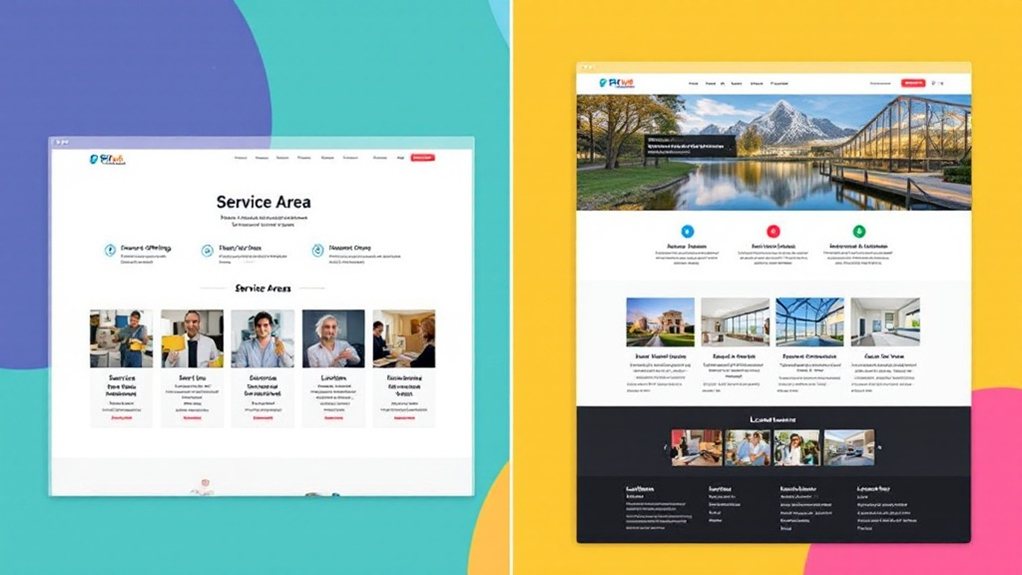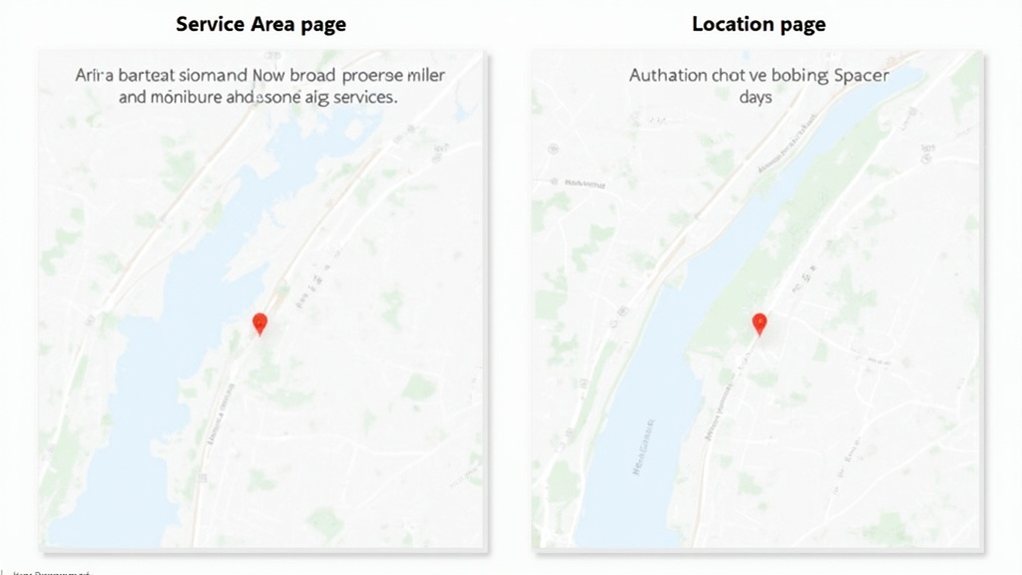Service area pages target specific geographic markets without a physical location, allowing you to rank for local keywords. Location pages are tied to a business's physical address, guiding customers to the exact branch or store. While service area pages expand your reach, location pages showcase your brick-and-mortar locations. Leveraging both strategies provides comprehensive online coverage and brand presence across multiple regions. To learn more about how to effectively implement these local SEO tactics, keep reading.
Definition and Purpose of Service Area Pages and Location Pages

Since service area pages and location pages serve distinct purposes, it's important to understand their definitions and objectives. Service area pages are designed to boost a company's web presence by targeting specific geographical markets where they offer services, even without a physical location. Allows targeting of a larger, more diverse set of locally focused keywords In contrast, location pages are tied to a business's physical address and are often linked to its Google Business Profile, guiding customers to the exact branch or store. Both page types play crucial roles in local SEO, but with differing strategies to enhance visibility for location-based searches and cater to the needs of businesses with varying geographic coverage.
Creation and Structure of Service Area Pages and Location Pages

Creating effective service area pages and location pages requires careful consideration of their key elements. For service area pages, include your company details, geographical content, service descriptions, local engagement, and visuals. Ensure each page has unique content to avoid duplicates. Optimize for SEO, incorporate customer testimonials, and provide comprehensive information. Service area pages allow a business without physical locations to rank organically for local terms. Location pages should feature the physical address, local details, service offerings, hours, and directions. Conduct keyword research, maintain mobile-friendliness, highlight local partnerships, and regularly update the content. Leverage SEO audit tools to identify improvement areas for both page types. By focusing on these best practices, you can develop compelling service area and location pages that effectively engage your target audience.
Benefits to Businesses From Service Area Pages and Location Pages

Why would businesses benefit from implementing service area pages and location pages on their website? Both provide enhanced visibility and targeted content that can drive online leads and conversions.
Businesses can:
- Expand their local SEO reach without a physical presence in certain areas through service area pages.
- Showcase brick-and-mortar locations and provide essential customer information via location pages.
- Combine both strategies for comprehensive online coverage and brand presence across multiple regions.
- Leverage the synergy between local SEO tactics and general optimization for maximum visibility.
- Service area pages can serve as an alternative to the homepage for location-based searches.
Ultimately, service area pages and location pages empower businesses to adapt their digital strategy as search algorithms evolve, giving them a competitive advantage.
Audience Interaction With Service Area Pages and Location Pages
Your audience's interaction with service area and location pages can significantly impact your business. Providing personalized local content tailored to each page's target audience can boost engagement and lower bounce rates. Additionally, reviews and rankings on these pages play a crucial role in attracting and retaining customers.
Personalized Local Content
When crafting personalized local content for your service area pages and location pages, the key is to make a genuine connection with your target audience. Localize the information by incorporating details about local landmarks, events, and demographics to demonstrate your understanding of the area. Highlight your employees' ties to the community to build trust and credibility. Use customer testimonials specific to each service area, and include unique visuals related to the location. Additionally, showcase your involvement in local events or charity efforts to foster a sense of community.
- Localize information
- Highlight employee connections
- Use testimonials
- Include unique visuals
- Showcase community involvement
Bounce Rate Impact
Bounce rate is a critical metric that reflects the level of audience engagement with your service area pages and location pages. Service pages tend to have a lower bounce rate of 20 to 30% due to users' specific intent. Generally, service area pages tend to have lower bounce rates, around 20-30%, as they cater to users with specific geographic intent. In contrast, location pages linked to physical addresses often enjoy lower bounce rates due to higher-intent local searchers. Optimizing your content relevance and user experience can help reduce bounce rates across both page types. By understanding these nuances, you can fine-tune your SEO strategies to attract and retain the right audiences for your business.
Reviews and Rankings
Reviews and ratings play a pivotal role in the performance of both service area pages and location pages. However, their influence varies between the two. For service area pages:
- Reviews often depend on a physical presence linked to a Google Business Profile, which isn't always necessary.
- Ranking improvements come from integrating localized content and maps, rather than reviews alone.
- Service area pages are effective for businesses without a physical address, promoting services across broader regions.
- The visibility of service area pages may also depend on leveraging relevant location-based keywords in the content.
In contrast, location pages heavily rely on reviews and ratings to enhance local SEO efforts and boost visibility in the local pack. Optimizing these factors is crucial for both service area and location pages, albeit in different ways.
Distinguishing Between Geo Pages and Location Pages
Distinguishing between service area pages and location pages is crucial for businesses seeking to optimize their local search presence. Service area pages target specific geographic regions without a physical office, emphasizing localized content to attract nearby customers. In contrast, location pages cater to users seeking services from a known business location, highlighting the unique offerings and address of each physical site. Businesses must strategically utilize both types of pages to enhance their local search presence and provide a seamless user experience.
The key differences are outlined in the table below:
| Feature | Service Area Pages | Location Pages |
|---|---|---|
| Focus | Geographic service areas | Physical business locations |
| Content | Localized keywords and information | Location-specific details |
| SEO | Enhance local visibility | Improve rankings through consistent NAP |
| Design | Contact info, maps, service descriptions | Detailed business information, maps, testimonials |
Optimization Strategies for Service Area Pages and Location Pages
Optimizing service area pages and location pages is paramount for businesses seeking to enhance their local search visibility. Whether it's conducting thorough keyword research, crafting compelling content, or implementing technical best practices, a strategic approach is essential. Service area pages play a crucial role in establishing local search authority. Key tactics include:
- Emphasizing local relevance through community references and unique visuals
- Prioritizing user experience with clear contact information and mobile optimization
- Leveraging customer testimonials and first-party data to build credibility
- Regularly tracking performance and applying insights to refine your strategies
Leveraging Local SEO With Service Area Pages and Location Pages
Leveraging local SEO effectively requires a strategic approach that incorporates both service area pages and location pages. Service area pages extend your reach beyond your immediate vicinity, helping you target long-tail, geo-modified keywords with lower competition. Service-area businesses must focus on content and meta tags to gain visibility. Meanwhile, location pages attract local users searching for businesses near them, potentially appearing in the coveted Local Pack if optimized properly. By utilizing both page types, you can enhance your overall visibility in search results, improve your search engine rankings, and gain a competitive edge over rivals. Crafting informative, user-friendly content and optimizing for relevant keywords are crucial for maximizing the benefits of these local SEO tools.
Driving Customer Engagement Through Service Area Pages and Location Pages
Effective service area pages and location pages can significantly drive customer engagement and foster deeper connections with your target audience. By incorporating localized content, clear calls-to-action, and visually appealing elements, you can create a personalized experience that resonates with your local customers. Consider these strategies to enhance engagement:
- Highlight unique value propositions and local testimonials to build trust and credibility.
- Provide detailed, service-specific content to help customers make informed decisions.
- Incorporate area-specific highlights and seasonal/timely content to stay relevant and connected.
- Gather customer feedback through surveys and adjust your content accordingly.
Optimizing these pages for SEO and tracking performance metrics will further ensure you're meeting the needs of your local audience and staying ahead of the competition.
Enhancing Competitive Advantage With Service Area Pages and Location Pages
Optimizing your service area pages and location pages can provide a significant competitive advantage. By tailoring your content and targeting less competitive local keywords, you can improve your visibility in search results and reach a wider audience. Leveraging location-specific data to enhance your conversion strategies can further solidify your position in the market.
Targeted Local Visibility
Targeted local visibility is essential for businesses seeking to enhance their competitive advantage. Service area pages and location pages play distinct yet complementary roles in boosting your local SEO. While location pages focus on physical store presence, service area pages target broader geographic regions where you provide services. To maximize their impact:
- Craft compelling, location-specific content that incorporates relevant keywords.
- Create multiple service area pages to cover a wider range of locations.
- Leverage customer reviews and testimonials to build trust.
- Consistently update and maintain the accuracy of all local listings.
Striking the right balance between these two page types can significantly improve your visibility and connect you with potential customers in your target markets.
Optimizing Conversion Strategies
By optimizing your conversion strategies with service area pages and location pages, you can enhance your competitive advantage in the local market. Ensure your calls-to-action are clear and compelling, guiding users towards desired actions. Responsive design and quick loading times improve user experience, boosting engagement and conversions. Provide local information, such as business hours and contact details, to build trust and credibility. Leverage unique, engaging content to encourage users to convert. Service area pages can increase visibility in targeted locations, while location pages can highlight local nuances, further enhancing relevance. Combining these strategies with localized SEO can drive more high-intent traffic and leads.
Fostering Customer Trust With Service Area Pages and Location Pages
Building customer trust is paramount for service area and location pages. By embracing transparency, your business can cultivate trust and credibility. Consider these strategies:
- Clearly define your service areas, so customers understand your reach.
- Provide comprehensive contact information, making it easy to reach out.
- Showcase client testimonials, reinforcing your reputation.
- Offer detailed service descriptions, managing customer expectations.
Maintaining consistency across your pages further strengthens your trustworthy image. Integrating with Google Business Profiles and optimizing content quality and local search visibility are also crucial for fostering trust through service area and location pages.
